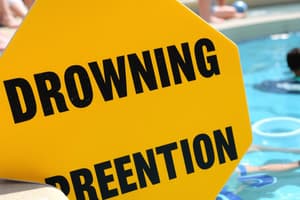Podcast
Questions and Answers
What is the therapeutic goal in the management of nonfatal drowning?
What is the therapeutic goal in the management of nonfatal drowning?
- Prevent hypovolemic shock and dysrhythmias
- Manage hypoxia, acidosis, and hypothermia
- Ensure adequate airway and respiration
- Maintain cerebral perfusion and adequate oxygenation to prevent further damage to vital organs (correct)
What is the factor with the greatest influence on survival in nonfatal drowning?
What is the factor with the greatest influence on survival in nonfatal drowning?
- Hypoxia and acidosis management
- Cardiopulmonary resuscitation (correct)
- ECG monitoring
- Hypothermia management
What is the most common type of shock in nonfatal drowning management?
What is the most common type of shock in nonfatal drowning management?
- Obstructive Shock
- Hypovolemic Shock (correct)
- Cardiogenic Shock
- Distributive Shock
What are the possible complications after resuscitation in nonfatal drowning?
What are the possible complications after resuscitation in nonfatal drowning?
What is the best prevention measure for drowning accidents?
What is the best prevention measure for drowning accidents?
Flashcards
Goal of Nonfatal Drowning Management
Goal of Nonfatal Drowning Management
Keeping blood flow to the brain and adequate oxygen levels to prevent further damage to important organs.
Key Factor in Nonfatal Drowning Survival
Key Factor in Nonfatal Drowning Survival
Providing CPR can significantly increase the chance of survival for a victim of nonfatal drowning.
Common Shock Type:
Common Shock Type:
The most common type of shock encountered in nonfatal drowning management is hypovolemic shock, which results from fluid loss.
Possible Complications After Resuscitation
Possible Complications After Resuscitation
Signup and view all the flashcards
Best Prevention for Drowning
Best Prevention for Drowning
Signup and view all the flashcards
Study Notes
Nonfatal Drowning Management
- The therapeutic goal is to restore oxygenation and perfusion, while preventing further complications.
Factors Influencing Survival
- The factor with the greatest influence on survival is the duration of submersion, as it directly affects the degree of hypoxic brain injury.
Shock Management
- The most common type of shock in nonfatal drowning management is hypovolemic shock, which occurs due to fluid shifts and loss of blood volume.
Complications after Resuscitation
- Possible complications after resuscitation in nonfatal drowning include acute respiratory distress syndrome (ARDS), pneumonia, electrolyte imbalances, and cardiac arrhythmias.
Prevention Measures
- The best prevention measure for drowning accidents is proper supervision, particularly of children and inexperienced swimmers, accompanied by the implementation of safety measures such as fencing and lifeguarding.
Studying That Suits You
Use AI to generate personalized quizzes and flashcards to suit your learning preferences.




